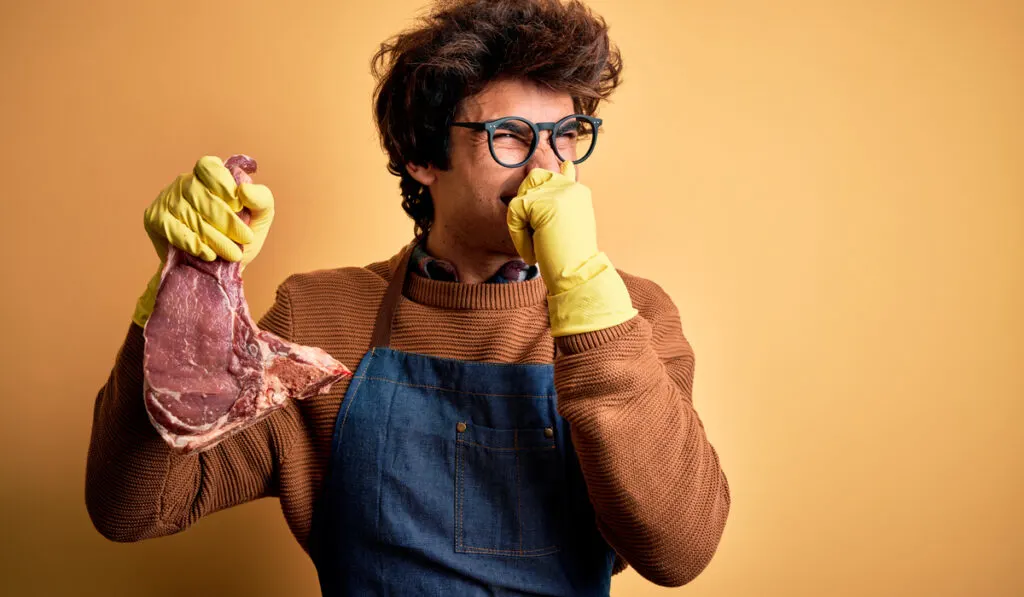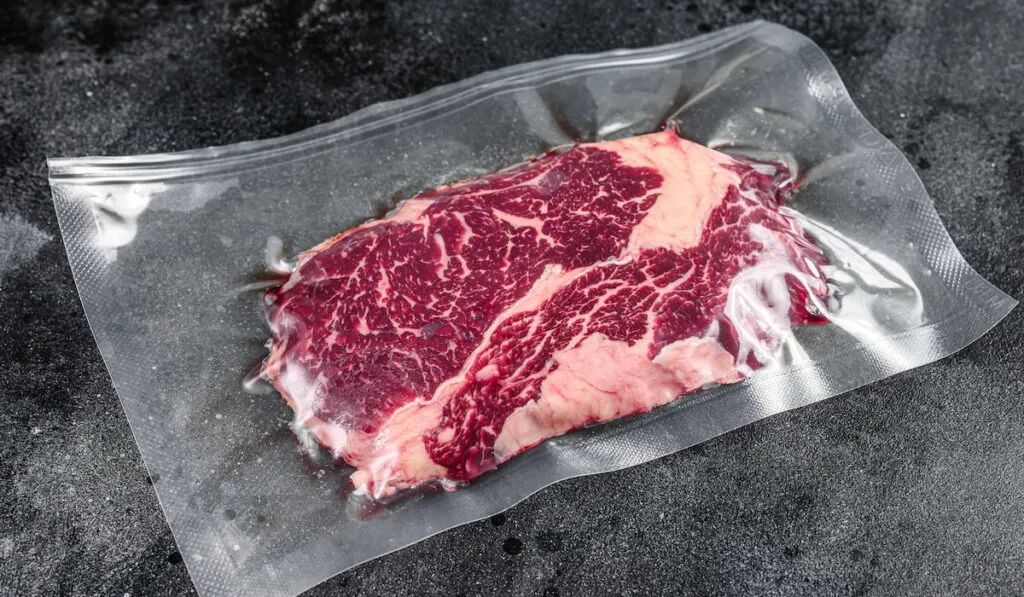Do you love eating beef? Beef and other types of meat are excellent and many people feel that a meal is not complete without meat. When selecting your steaks at the market, you naturally want to choose fresh beef.
How can you tell that a steak or beef roast is bad?
There are many ways to tell if beef is bad or not. You can check the color, smell, or texture.
The ultimate way to tell that beef is bad, however, is to check the expiration date because beef will begin to go bad when it has passed its expiration date.
How do you prevent beef from spoiling? For how long can beef remain fresh? We’ll cover these questions and more in the rest of this article.
Table of Contents
Signs That Beef is Bad
Spoiled beef is not safe for consumption, so you need to make sure that your beef is still fresh. Here are some ways to tell if your beef is bad or not:
1. Pungent Smell
Spoiled beef has a bad smell that can make you want to gag. This odor can be described as putrid and tangy.

Bad beef has a lot of bacteria such as Pseudomonas spp. and Lactobacillus spp. These bacteria give your beef a very bad smell as they act on it.
It is very easy to smell bad beef when you have kept it in a bag or a concealed place. Opening the meat will release all the disgusting odor.
It is still possible for spoiled beef to appear odorless. Maybe you missed it when it was smelly or the room is well-ventilated. Aside from the presence of a sour smell, there are other ways to tell that beef is bad.
2. Presence of Maggots
Even though you hate the smell of spoiled beef, insects love the smell. Different species of flies look for decaying meat to lay their eggs. One of the easiest ways to tell that beef is bad is when you see maggots on it.
The presence of maggots is an indicator that you should dispose of your beef. You should dispose of your beef when you see maggots because they can carry diseases and may have already contaminated the meat.
3. Slime
Several biochemical processes can occur on bad meat. One common process that occurs in meat that has spoiled is the increase in bacteria colonies in it. These microbes can give your beef a slimy feel. They will also cause your beef to quickly break apart when you press a finger in it or squeeze it.
Not all bad beef will feel slimy. If your beef has been kept in a breezy room, it will feel dry when touched. You need to use other methods to tell if your beef is bad or not.
4. Color Change
Fresh beef is red. Beef has a pigment called oxymyoglobin that can become red in the presence of oxygen. As beef goes bad, more of this pigment will be consumed by bacteria, and soon, the steak will lose its pigmentation.
Bad beef changes color from red to brown or gray according to the temperature, pH, light, and other external factors.
5. Presence of Mold
Moldy beef steak or roast beef is unsafe for consumption. Mold appears when fungi growing in the beef are matured enough to reproduce and spread to other parts of the meat.
You should dispose of your beef immediately you find mold growing on it.
How to Prevent Beef from Spoiling
Can you extend the shelf life of your beef? Here are some ways to properly store your beef so that it does not go bad so quickly:
1. Refrigerate It
You should store your steak in a fridge at 40°F (4°C) or lower temperature. While you cannot store your beef forever in a fridge, it can help increase the shelf life to extend the time that you have to eat it.
You should not store beef for more than five days in the fridge because it can become unsafe for consumption after this.
2. Do Not Unseal It
Unless you have to collect from it, you should not unseal your steak from its store pack. Meat steaks are usually kept well in stores and will not spoil quickly so long as they are in their pack.

3. Fry or Roast It
Frying or roasting steak can reduce the moisture in it. This can help extend the shelf life as moisture causes food items to spoil quickly. After frying or roasting your beef, remember to store it properly.
4. Do Not Keep It in a Breezy Area
Keeping your beef in a breezy place such as near a window can expose it to the spores of bacteria, fungi, and other microbes. Beef kept like that can spoil very quickly.
You should keep your beef in a cool and dry place.
5. Cook It
Cooking beef will not stop it from going bad forever, but it will buy you some time. It will keep for a little longer until you decide what you would like to use it for.
Related Questions and Answers
1. Is Beef Safe to Eat When it Turns Brown?
Some meats are prepared to be brown. If the steak became brown on its own, it could be bad and unsafe for consumption. Use different methods to check if it is bad.
If the brown beef is bad, do not eat it. Instead, dispose of it immediately.
2. Can You Eat Spoiled Meat if You Cook It?
Do not eat spoiled meat.
Microbes in spoiled meat are acting on it to change some biochemical properties of the meat and render it unsafe for consumption.
You should dispose of spoiled beef. Do not try to cook it.
Also, make sure to properly clean the shelf or container in which you kept the meat so that other food items nearby do not go bad.
3. Is Beef Good if It Is Slimy But Smells Okay?
Beef kept in an open space or meat that has access to the open air will not smell very bad. This does not mean that the beef has not gone bad. You should use other methods to check if it is bad.
If the beef is slimy, there is a high chance that it is bad. Other methods to tell if it is bad are by checking for mold and checking the color.
4. What Happens If You Eat Spoiled Beef?
Spoiled beef can make you sick. Remember that beef is cow meat. As an animal, there are many shared diseases between cows and people. This means that if you eat spoiled beef, you can easily get sick.
Do not eat or even try to taste spoiled beef as it can make you sick.

5. Can You Eat Beef After Its Expiration Date?
Stores usually fix the expiration date of meat for days earlier than when the beef would go bad. If beef is just a day or two older than its expiration date and it still looks good after checking it with all the methods listed in this article, you can eat it.
Do not eat beef that looks bad or has passed its expiration date by more than two days.
Final Thoughts
Spoiled beef can become brown or gray, develop a slimy texture, and smell bad.
There are many ways to tell if beef is bad, so you should not rely on just one method. Remember that you should not eat bad beef so that you do not get sick.
Resources
- https://www.healthline.com/nutrition/ways-to-tell-if-ground-beef-is-bad#3.-Perform-a-smell-test
- https://www.insider.com/how-to-tell-if-beef-is-bad-2019-5
- https://food.onehowto.com/article/how-to-tell-if-beef-is-spoiled-10524.html
- https://www.eatingwell.com/article/80518/do-food-expiration-dates-really-mean-anything/
- https://spoonuniversity.com/how-to/meat-goes-bad-how-to-tell
